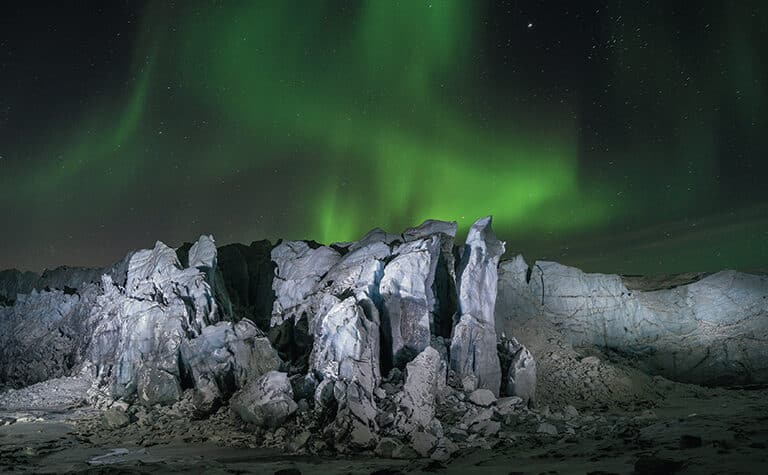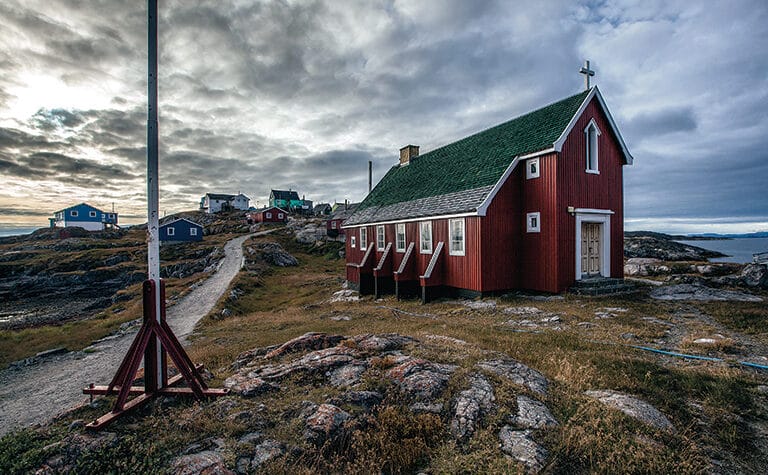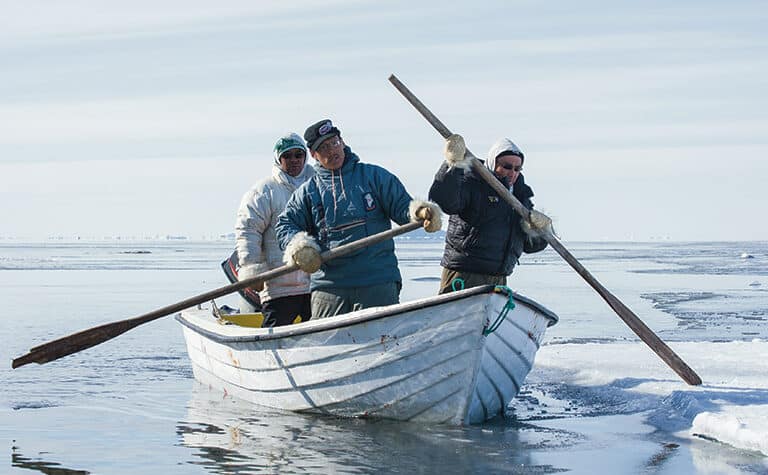
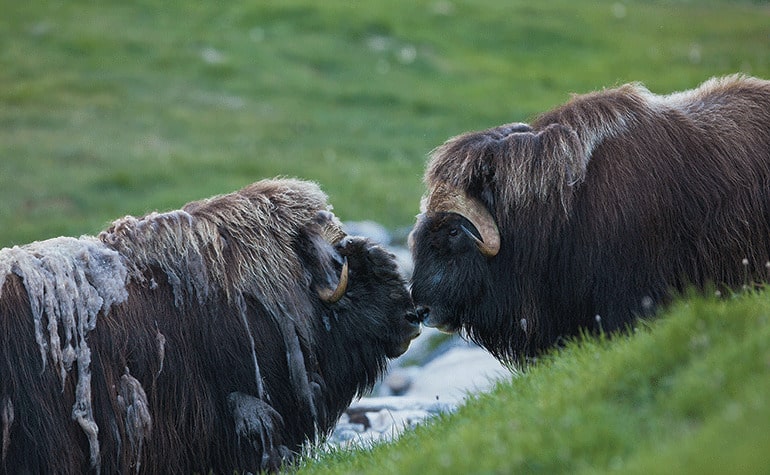
Musk-oxen – living on the edge
Jump to chapter
Published: 08/11/2016
Reading time: 6 minutes
Text & photos: Carsten Egevang
Article from the former magazine, Greenland Today
They resemble remote cousins of the Bison ox, but they are genetically closer related to goats. With their long summer hair full of woolly tufts you could call them Greenland’s hippy cows, but in reality, the musk-ox is uniquely suited to life in the Arctic.
You can’t quite resist smiling when you meet Greenland’s biggest land mammal, the musk-ox. Its extremely long hair smudges the contour of its body, making its legs appear tiny which gives the animal a slightly comical appearance. But make no mistake! The musk-ox is a top-tuned organism that is supremely well-adapted to the Arctic environment. Adaptation is necessary for survival in one of the most extreme regions of Greenland: The Thule Region.
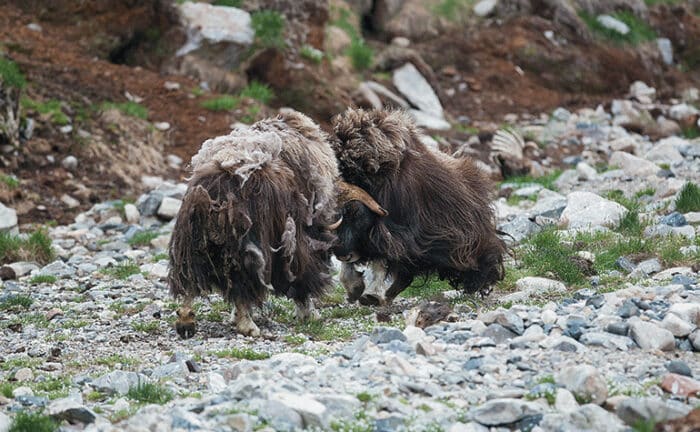
Introduced to Thule
The musk-ox is not naturally occurring in the Thule region in modern times, but it could have been. It migrated to Greenland from Arctic Canada – just a little north of the Thule region, but the gigantic Humboldt Glacier lies like a physical barrier in the landscape and has prevented the musk-ox from spreading southwards.
Instead, it has continued its »invasion« of Greenland to the east and its natural occurrence in Greenland is in the National Park in North and Northeast Greenland and in the region of Ittoqqortoormiit. It was from here that the musk-oxen was taken at the beginning of the 1960s and then released in the Kangerlussuaq area. In all, 27 musk-oxen were moved to Kangerlussuaq, where they met the perfect conditions for growth and this population has today grown to well over 10,000 individuals.
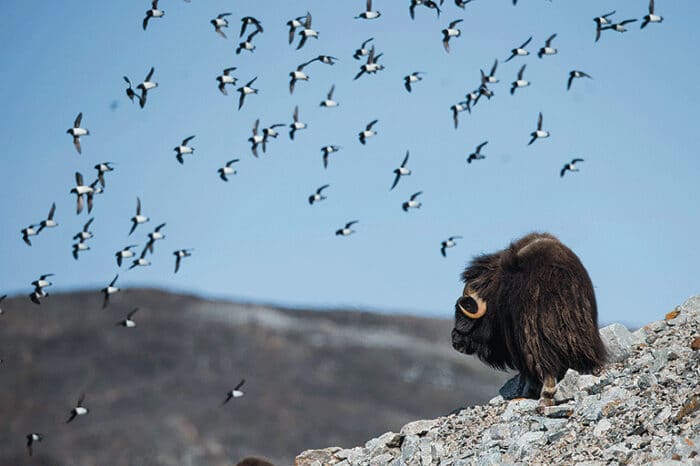
Musk-oxen have subsequently been moved from the successful population in Kangerlussuaq to other locations in Greenland, among them two places in the Thule region. Musk-oxen have previously lived in the area around Inglefield Land in the northern part of Thule, but these disappeared from the region in the 1860s. 14 individuals were released here in 1986 and this population now has around 300 individuals today.
In 1986, seven musk-oxen were also released in the Cape Atholl area in the southern part of the Thule area, but the area here is less suitable for the species and today the population consists of hardly more than 50 individuals. In all, these two musk-oxen populations provide the locals with an opportunity to harvest about 80 animals each year, giving them access to meat from land mammals which is a good supplement to a diet that otherwise consists mainly of marine mammals.
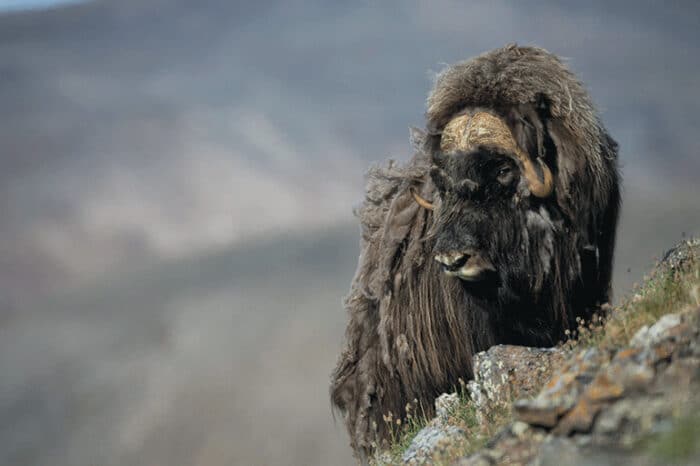
Curly hooves and woolly coats
However, there was something wrong with the musk-oxen at Atholl. Some of the animals had overgrown hooves, where abnormal growth made the hooves curl upwards making it difficult for the animals to move around. It has been suggested that the deformity is caused by too little wear of the hooves because the musk-oxen at Cape Atholl mainly stays in soft, mossy areas near the little auk colonies. However, the explanation was found elsewhere. It turned out that one of the original five musk-ox cows that gave rise to the population at Cape Atholl back in 1986 also had deformed hooves, thus sending the genetic defect down through subsequent generations.
Musk-oxen survive in one of the most extreme environments in the world – at the very edge of what is physically possible for a herbivore – and this requires special adaptation. The species has a large body with a relatively small surface and this ensures minimal heat loss. Its big, strong muzzle is ideally suited for sparse grazing and the crescent-shaped hooves give a solid grip on ice and rocks.
However, the most noticeable thing is the musk-ox’s thick coat which is made up of two players. There is an outer layer of up to 60cm long guard hairs that provide an effective barrier against wind and weather. Underneath there is a very dense, thick woolly under-hair – qiviut – which provides unrivaled insulation against the cold. The musk-ox’s underhair consists of very light and soft, but also very strong fibers which are very dense, and herein lies the secret of how the species can live all year round in such an extreme environment.
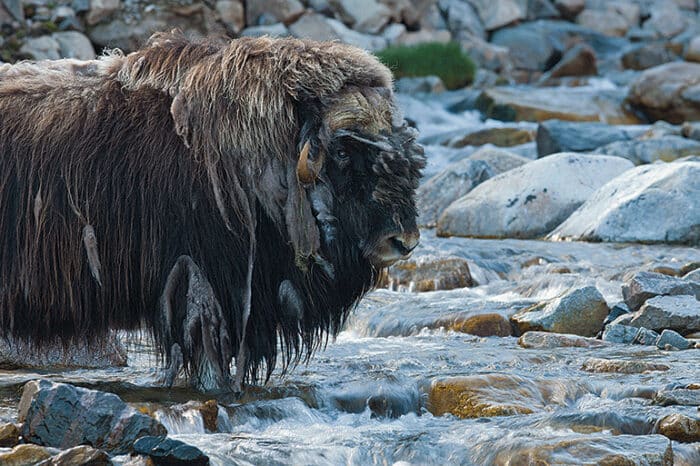
Kings and oxen in Thule
There is, however, another factor that makes the difficult life of the musk-oxen live so far to the north a little easier. The help comes from a very unexpected source; Thule is the home of Greenland’s most abundant bird, the little auk, with its colonies of hundreds of thousands, sometimes millions of individuals. The many little auks find their food at sea, but when they return to the colony to feed their young, they leave droppings. On its own, this is insignificant, but when millions of birds each do this several times a day in the same area, it means a massive supply of nutrients to a High Arctic environment that is otherwise considered to be extremely nutrient-poor.
Thus the vegetation veritably flourishes close to the little auk colonies, where the grass grows tall and green, while the neighboring areas appear grey and barren. Therefore, the musk-oxen are attracted to the little auk colonies where the grazing is particularly favorable.
It is not only the musk-oxen who enjoy the unique transport of nutrients from sea to land. In connection with the little auk colonies in Thule, a high incidence of other herbivores such as caribou and Arctic hares has been observed. And where there are many animals to prey on, there are always many predators, and species such as Arctic foxes, gulls, and falcons are also attracted by the abundance of birds in one place.
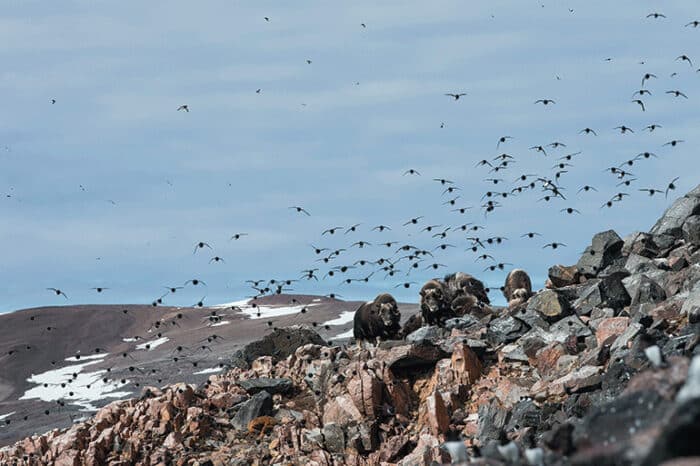
Musk-oxen
- Scientific name: Ovibosmoschatus (the species’ genus name means »sheep ox«).
- Weight: Males usually 300-340 kg, females up to 220 kg. Some bulls can weigh more than 400 kg.
- Height at shoulder: 120-150 cm.
- Diet: Grasses, willow scrub, and herbs. The musk-ox is extremely selective and it actively seeks the plants or plant parts that provide the most energy.
- Reproduction: Typically delivering one calf (rarely twins) after a 7.5 to 9-month gestational period. Calves are born at the end of the winter. Birth weight is 8 – 15 kg and calves suckle for 12 to 18 months.
- Life expectancy: Musk-oxen in the wild live for up to 24 years.
- Dispersal: Found naturally in North and Northeast Greenland (southernmost location: the area around Ittoqqortoormiit). Introduced into various areas (Ivittuut, Kangerlussuaq, Naternaq, Svartenhuk Peninsular, and the Thule region) in West Greenland.
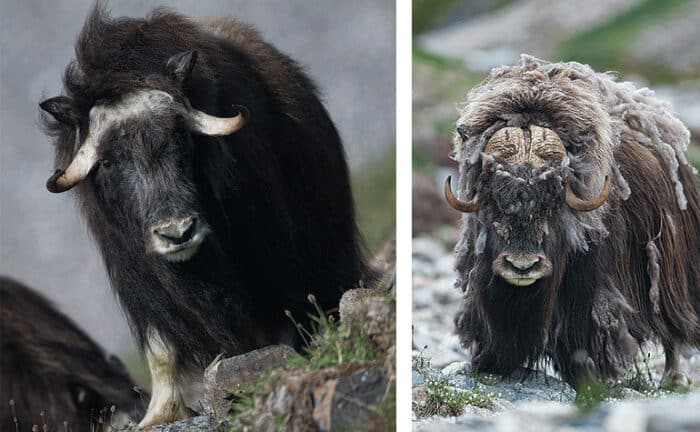
About the author
- Carsten Egevang was born in 1969.
- Lives in Copenhagen. Has lived in Nuuk for 6 years.
- PhD in biology.
- Primary field of work: Arctic marine birds.
- Spends most of his working hours today taking photographs.
- Gives talks and is the author of several photo books about Greenland.
- Administrator of the Greenland photo agency ARC-PIC.COM.
- Winner of several international photo competitions.
- BBC Wildlife Photographer of the Year in 2009.
- Nature photographer of the year in 2011.
- Winner of Greenland’s »Environment and Nature Award« in 2012.
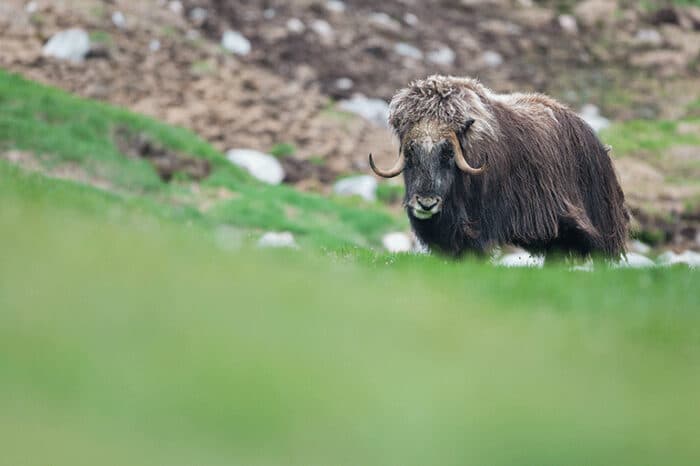
Read more articles from Guide to Greenland
-
5.00(2)

Snowshoe Hiking & Sauna experience | Ilulissat | Disko Bay
Tour startsIlulissatDuration4.5 hoursFrom 790 DKKSee more -
2025 departures!

Arctic Circle Winter Adventure | Nuuk & Sisimiut | 8 Days
Tour startsFrom CopenhagenDuration8 daysFrom 25995 DKKSee more -
Flights included!
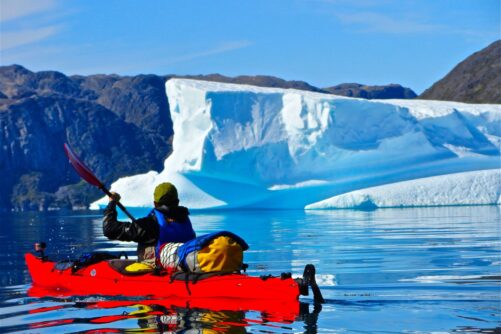
Hike and Kayaking | 10 days | South Greenland
Tour startsFrom IcelandDuration10 daysFrom 26500 DKKSee more -
5.00(17)Ideal For Cruise Guests

Private guided tour by car in the capital of Greenland | Nuuk
Tour startsNuukDuration1.5 hoursFrom 2250 DKKSee more -
New Exiting Tour

Guided tour in Nuuk with UTV (Utility Terrain Vehicles) | Nuuk
Tour startsNuukDuration1.5 hoursFrom 975 DKKSee more -
Limited space for this price!
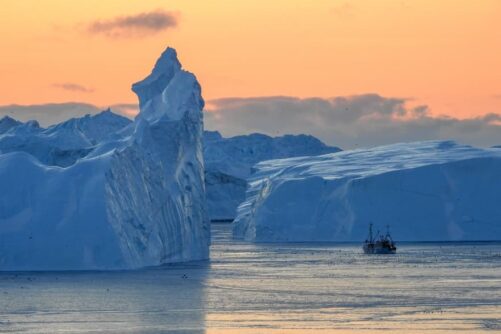
Best Of Ilulissat | 5 days | Disko Bay
Tour startsFrom IcelandDuration5 daysFrom 24400 DKKSee more -
4.80(10)

Open boat Midnight Cruise To Ilulissat Icefjord | Ilulissat | Disko Bay
Tour startsIlulissatDuration2 hoursFrom 790 DKKSee more -
New tour!

Dog Sledding the Arctic Circle Trail to “the Viewpoint” | Sisimiut
Tour startsSisimiutDuration8 hoursFrom 4500 DKKSee more -
Price for 4 people!

Glacier Landing by Helicopter | Qaqortoq | South Greenland
Tour startsQaqortoqDuration1.5 hoursFrom 22100 DKKSee more -
Accommodation and tours included!
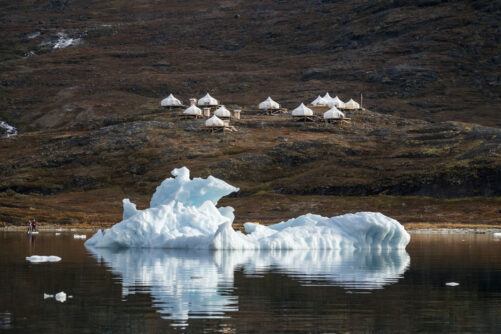
Arctic Capital to Wilderness Escape | 4 Days in Nuuk & 2 Nights in Nuuk Icefjord Camp
Tour startsNuukDuration6 daysFrom 15400 DKKSee more -
Flights from Reykjavík included!
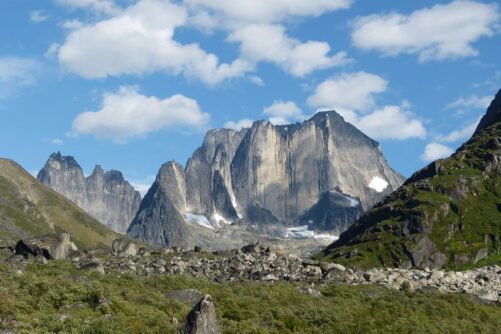
Ice, Big Walls & Hot Spring | South Greenland Explorer
Tour startsFrom IcelandDuration15 daysFrom 32200 DKKSee more -
Flights Included!
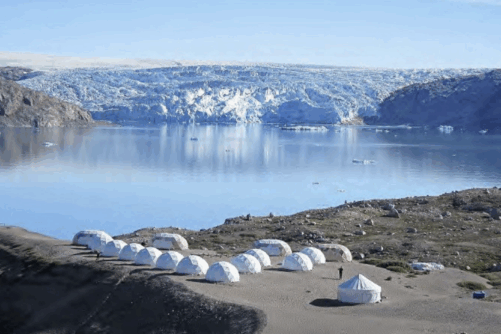
Wonders of Greenland | South Greenland
Tour startsFrom IcelandDuration8 daysFrom 25300 DKKSee more -

Snowshoe to the top of Lille Malene | Nuuk
Tour startsNuukDuration5 hoursFrom 3950 DKKSee more -
5.00(1)Pay by the Hour

Pay by the Hour Private Charter | Ilulissat | Disko Bay
Tour startsIlulissatDuration2 hoursFrom 4600 DKKSee more -
5.00(32)
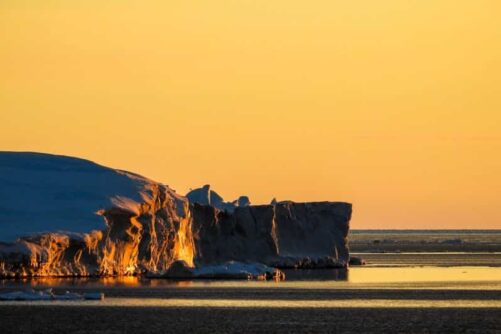
Boat Trip among the Icebergs | Ilulissat | Disko Bay
Tour startsIlulissatDuration2.5 hoursFrom 895 DKKSee more -
5.00(1)1 to 6 people included!

The Abandoned Settlement of Kangeq & The Island Of Hope | Nuuk
Tour startsNuukDuration3 hoursFrom 6900 DKKSee more

